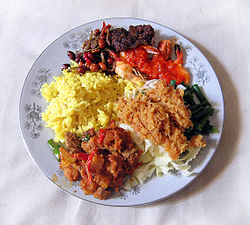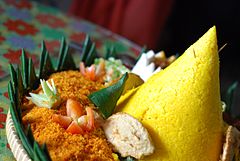
Back Nasi kuning BJN Nasi kuning Spanish Nasi kuning French Nasi kuning (Indonesia) ID ナシクニン Japanese Nasi kuning JV 나시 쿠닝 Korean Sega kuning MAP-BMS നാസി കുനിംഗ് Malayalam Nasi kuning Malay
 Nasi kuning personal serving, surrounded with rich Indonesian dishes | |
| Alternative names | Nasi kunyit, Pulut kuning |
|---|---|
| Course | Main course |
| Place of origin | Indonesia[1] |
| Region or state | Java |
| Associated cuisine | Indonesia, also found in Malaysia, Singapore, the Netherlands, the Philippines, Suriname, Sri Lanka (known as kaha buth) and South Africa |
| Serving temperature | Hot and room temperature |
| Main ingredients | Rice cooked in turmeric surrounded with side dishes |
| Similar dishes | Hsi htamin |

Nasi kuning (Indonesian for: "yellow rice"),[2] or sometimes called nasi kunyit (Indonesian for: "turmeric rice"), is an Indonesian fragrant rice dish cooked with coconut milk and turmeric,[3][4] hence the name nasi kuning (yellow rice).[1]
In the Philippines, a related dish exists in Mindanao, particularly among the Maranao people, where it is known as kuning. Like the Indonesian version, it primarily uses turmeric, but also adds lemongrass and does not use coconut milk.[5][6] A similar dish is also found in Sri Lankan cuisine where it is known as kaha buth (and Lamprais) and draws from both Indonesian and Sri Lankan influences.[7][8]
- ^ a b Salloum, Habeeb (14 December 2003). "Recipe: Nasi Kuning – Indonesian Yellow Rice | ThingsAsian". thingsasian.com. Retrieved 24 January 2018.
- ^ Holzen, Heinz Von (15 September 2014). A New Approach to Indonesian Cooking. Marshall Cavendish International Asia Pte Ltd. p. 51. ISBN 9789814634953.
- ^ Agostino, Helen; Kiting, Kathy (1999). Indonesia Kaleidoscope. Curriculum Corporation. ISBN 9781863663830.
- ^ Holzen, Heinz Von; Arsana, Lother (1999). The Food of Indonesia: Authentic Recipes from the Spice Islands. Periplus Editions. ISBN 9789625933894.
- ^ Balistoy, Ruby Leonora R. "Pagana Maranao—fostering culture of peace". Philippine Information Agency. Retrieved 5 March 2019.
- ^ Abdulwahab, Nabeelah T. "The Beauty, Warmth, and Hospitality of Pagana". Intangible Cultural Heritage Courier of Asia and the Pacific. International Information and Networking Centre for Intangible Cultural Heritage in the Asia-Pacific Region (ICHCAP). Retrieved 5 March 2019.
- ^ "Malay Dishes". YoungMelayu Sri Lanka.
- ^ Bullis, Douglas; Hutton, Wendy (2001). Food of Sri Lanka. Periplus. pp. 5, 14. ISBN 9625937609.
© MMXXIII Rich X Search. We shall prevail. All rights reserved. Rich X Search